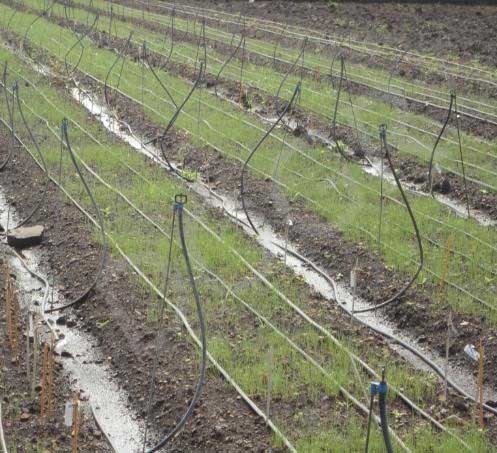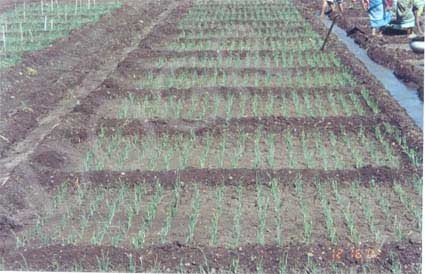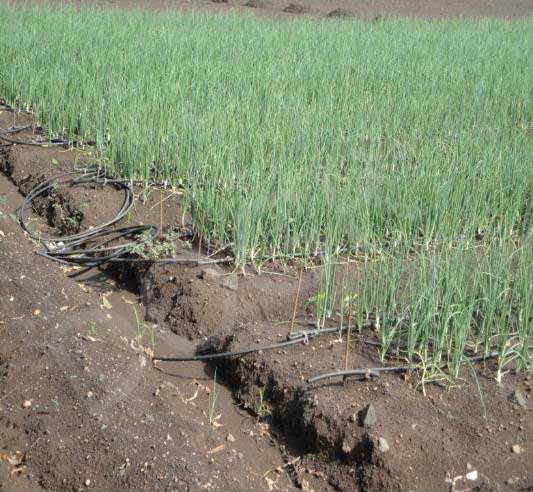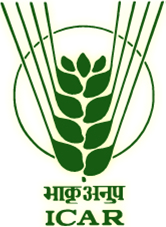Climate and Soil
Climate
Onion is a temperate crop but can be grown under a wide range of climatic conditions such as temperate, tropical and subtropical climate. The best performance can be obtained in a mild weather without the extremes of cold and heat and excessive rainfall. However, onion plant is hardy and in the young stage can withstand freezing temperature also. In India, short-day onion is grown in the plains and requires 10-12 hours day length. The long-day onion is grown in hills requiring 13-14 hours day length. For vegetative growth, lower temperature combined with short photoperiod is required whereas relatively higher temperature along with longer photoperiod is required for bulb development and maturity. The optimum temperature for vegetative phase and bulb development is 13-24˚C and 16-25˚C, respectively. It requires about 70% relative humidity for good growth. It can grow well in places where the average annual rainfall is 650-750 mm with good distribution during the monsoon period. Areas with low (< 650 mm) or heavy rainfall (>750 mm) are not particularly suitable for rain-fed crop.
Soil
Onion can be grown in all types of soils such as sandy loam, clay loam, silt loam and heavy soils. However, the best soil for successful onion cultivation is deep, friable loam and alluvial soils with good drainage, moisture holding capacity and sufficient organic matter. In heavy soils, the bulbs produced may be deformed. Onion crop can be grown successfully on heavy soil with application of organic manure prior to planting and preparation of the field for onion cultivation should be very good. The optimum pH range, regardless of soil type, is 6.0 - 7.5, but onion can also be grown in mild alkaline soils. Onion crop is more sensitive to highly acidic, alkali and saline soils and water logging condition. Onions do not thrive in soils having pH below 6.0 because of trace element deficiencies, or occasionally, Al or Mn toxicity.The threshold electrical conductivity of a saturation extract (ECe) for onion crop is 4.0 dS/m. When the ECe level exceeds this, crop yield starts declining.
Seasons
Sowing, transplanting and harvesting timings of onion in different regions of India
| Season | Time of seed sowing | Time of transplanting | Time of harvesting |
|---|---|---|---|
| Maharashtra and some parts of Gujarat | |||
| 1. Early Kharif | Feb.-Mar. | April-May | Aug.-Sept. |
| 2. Kharif | May-June | July-Aug. | Oct.-Dec. |
| 3. Late Kharif | May-June | July-Aug. | Oct.-Dec. |
| 4. Rabi | Oct-.Nov. | Dec.-Jan. | Apr.-May. |
| Tamil Nadu, Karnataka and Andhra Pradesh | |||
| 1. Early Kharif | Feb.-April | April-June | July-Sept. |
| 2. Kharif | May-June | July-Aug. | Oct.-Dec. |
| 3. Rabi | Sept.-Oct. | Nov.-Dec. | Mar.-Apr. |
| Rajasthan, Haryana, Punjab, UP and Bihar | |||
| 1. Kharif | June-July | July-Aug. | Oct.-Dec. |
| 2. Rabi | Oct.-Nov. | Dec.-Jan. | May-June. |
| West Bengal and Orissa | |||
| 1. Kharif | June-July | Aug.-Sept. | Nov.-Dec. |
| 2. Late Kharif | June-July | Aug-Sept. | Nov.-Dec. |
| 3. Rabi | Sept.-Oct. | Nov.-Dec. | Mar.-Apr. |
| Hilly areas | |||
| 1. Rabi | Sept.-Oct. | Oct.-Nov. | June-July |
| 2. Summer (Long day type) | Nov.-Dec. | Feb.-Mar. | Aug.-Oct. |
Onion Varieties
Recommended varieties for different seasons and regions of the country
|
Varieties |
Colour |
Season |
Region |
Days to maturity |
Yield potential |
Storability |
|
Bhima Super |
Red |
Kharif |
Chhattisgarh, Delhi, Gujarat, Haryana, Karnataka, Madhya Pradesh, Maharashtra, Odisha, Punjab, Rajasthan and Tamil Nadu
|
100-105 days |
20-22 t/ha |
Poor (1 to 1.5 months)
Medium (2-3 months) |
|
Late Kharif |
Gujarat, Karnataka and Maharashtra |
110-120 days |
40-45 t/ha |
|||
|
Bhima Red
|
Red |
Kharif |
Delhi, Gujarat, Haryana, Karnataka, Maharashtra, Punjab, Rajasthan and Tamil Nadu
|
105-110 days |
19-21 t/ha
|
Poor (1-1.5 Months)
Medium (2-3 months)
Medium (3 months) |
|
Late Kharif |
Gujarat, Karnataka and Maharashtra
|
110-120 days |
45-50 t/ha |
|||
|
Rabi |
Madhya Pradesh and Maharashtra |
110-120 days |
30-32 t/ha |
|||
|
Bhima Raj |
Dark Red |
Kharif |
Gujarat, Karnataka and Maharashtra |
100-105 days |
24-26
|
Poor (2-3 months) |
|
Late Kharif |
Gujarat, Karnataka and Maharashtra |
115-120 days |
40-45 t/ha |
|||
|
Rabi |
Delhi, Gujarat, Haryana and Rajasthan |
115-120 days |
25-30 t/ha |
|||
|
Bhima Dark Red |
Dark Red |
Kharif |
Chhattisgarh, Delhi, Gujarat, Haryana, Karnataka, Madhya Pradesh, Maharashtra, Odisha, Punjab, Rajasthan and Tamil Nadu |
100-110 days |
22-24 t/ha |
Poor (1.0 - 1.5 months) |
|
Bhima Shakti
|
Red |
Late Kharif |
Gujarat, Karnataka and Maharashtra
|
125-135 days |
35-40 t/ha
|
Good (5-6 months) |
|
Rabi |
Andhra Pradesh, Bihar, Chhattisgarh, Delhi, Gujarat, Haryana, Karnataka, Madhya Pradesh, Maharashtra, Rajasthan, Odisha, Punjab and Uttar Pradesh |
125-135 days |
28-30 t/ha |
|||
|
Bhima Kiran
|
Light red |
Rabi |
Andhra Pradesh, Bihar, Delhi, Haryana, Karnataka, Maharashtra, Punjab and Uttar Pradesh |
125-135 days |
28-32 t/ha |
Good (5-6 months |
|
Bhima Light Red |
Light red |
Rabi |
Karnataka and Tamil Nadu |
110-120 days |
36 - 40 t/ha |
Good (5 - 6 months ) |
|
Bhima Shubra |
White |
Kharif |
Chhattisgarh, Gujarat, Karnataka, Madhya Pradesh, Maharashtra, Odisha, Rajasthan and Tamil Nadu |
110-115 days
|
18-20 t/ha
|
Poor (2-3 months) |
|
Late Kharif |
Maharashtra |
120-130 days |
36-42 t/ha |
|||
|
Bhima Shweta |
White |
Kharif |
Chhattisgarh, Gujarat, Karnataka, Madhya Pradesh, Maharashtra, Odisha, Rajasthan and Tamil Nadu |
110-120 days |
18-20 t/ha
|
Medium (2 - 3 months) |
|
Rabi |
Andhra Pradesh , Bihar, Chhattisgarh, Delhi, Haryana, Karnataka, Madhya Pradesh, Maharashtra, Orissa, Punjab and Uttar Pradesh |
110-120 days |
26-30 t/ha |
|||
|
Bhima Safed |
White |
Kharif |
Chhattisgarh, Gujarat, Karnataka, Madhya Pradesh, Maharashtra, Odisha, Rajasthan and Tamil Nadu |
110-120 days |
18-20 t/ha |
Poor (1-1.5 months) |
Nursery
Nursery raising


Proper nursery management and transplanting are important operations in the onion crop. About 0.05 hectare nursery bed area is enough for getting seedlings to transplant in one hectare. The field should be ploughed 5-6 times to break clods and well pulverized to hold water. The debris of previous crops, weeds and stones should be removed before bed preparation. Apply half ton of well decomposed farmyard manure (FYM) at the time of last ploughing in 0.05 ha and mix well with soil. For raising nursery, raised bed of 10-15 cm height, 1.0 - 1.2 m width and length as per convenience may be prepared. The distance between beds should be at least 30 cm, so that water movements are uniform and drainage of excess water is possible. Raised bed is recommended for nursery because in the case of flat bed, water moves from one end to the other and there is a possibility of washing away of seeds. Drainage of excess water is also a major problem with the flat bed method of raising seedlings. Application of pre-emergence herbicide pendimethalin @ 0.2% is recommended to control weeds in nursery. About 5-7 kg seeds are required to raise seedlings for one hectare. Before sowing, seeds should be treated with thiram @ 2 g/kg of seed to avoid damage from damping off disease. Application of Trichoderma viride @ 1,250 g / ha is also recommended to manage damping off and raise healthy seedlings. Seeds should be sown in lines at 50 mm to 75 mm apart to facilitate the removal of seedlings for transplanting, quick weeding, spray of pesticides etc.
After sowing, the seeds should be covered with fine powdered farmyard manure or compost followed by light watering. Application of water through drip or micro sprinkler irrigation system helps in saving irrigation water (Fig. 2). Foliar spray of benomyl @ 0.2% is recommended to control soil borne diseases in the nursery. When the severity of thrips infestation is high, foliar application of Fipronil or profenopos @ 0.1% is recommended. Seedlings are available for transplanting in 35-40 days after sowing (DAS) for Kharif and 45-50 DAS for late Kharif and Rabi seasons.
Field Preparation
Land preparation for main field


Prior to transplanting, field should be ploughed and disked properly to eliminate debris and soil clods. Organic manures equivalent to 75 kg N/ha (approximately FYM 15 t/ha or poultry manure 7.5 t/ha or vermicompost 7.5 t/ha) should be incorporated at the time of last ploughing and beds with appropriate size should be prepared after leveling. Mostly, flat beds of the size 1.5-2.0 m width and 4-6 m length is formed. However, flat bed should be avoided to prevent water logging during Kharif or rainy season. Water logging favours Anthracnose disease which is most devastating during Kharif season. Broad bed furrows (BBF) of 15 cm height and 120 cm top width with 45 cm furrow are formed to achieve proper spacing and population density. It is suitable for drip and sprinkler irrigation as well. BBF is the best method for Kharif onion production because the excess water can be drained out through the furrow. This improves the aeration and helps in reducing the incidence of Anthracnose disease.
Transplanting
Proper care should be taken while selecting seedlings for transplanting. Over and under aged seedlings should be avoided for better establishment. At the time of transplanting, one third of the seedling top should be cut to get good establishment. The onion seedling should be transplanted after dipping roots in carbendazim solution (0.1%) for two hours to reduce the incidence of fungal diseases during the establishment. The optimum spacing is 15 cm between the rows and 10 cm between plants.


Drainage channel to remove excess water
Fertilizers
Fertilizers and manures
Nutrient removal by onion crop mainly depends upon bulb yield, variety, quantity of fertilizers applied, soil condition and season. The results of the experiment carried out at DOGR, Rajgurunagar showed that onion crop removes about 90-95 kg of N, 30-35 kg of P2O5, and 50-55 kg of K2O to produce 40 t onion bulbs/ha. Therefore, it is necessary to apply plant nutrients in a balanced manner externally through different sources for sustainable onion production and soil health. Based on the results of field experiments conducted at DOGR, recommended doses of organic manures and fertilizers have been standardized and presented in Table 3. Fertilizer requirement of long day onion (grown in the hills) is higher than the short day onion crop due to its longer crop duration and yield potential.
Fertilizer schedule for onion (per ha)
|
Schedule |
N |
P2O5 |
K2O |
Organic manures |
|
Kharif onion (Yield potential – 25-30 t/ha) |
||||
|
Basal |
25 kg |
40 kg |
40 kg |
Organic manures equivalent to 75 kg N (FYM – Approx. 15 t/ha or Poultry manure- Approx. 7.5 t/ha or Vermicompost – Approx. 7.5 t/ha) |
|
30 DAT |
25 kg |
- |
- |
- |
|
45 DAT |
25 kg |
- |
- |
- |
|
Total |
75 kg |
40 kg |
40 kg |
- |
|
Late Kharif and Rabi onion (Yield potential- 40-50 t/ha) |
||||
|
Basal |
40 kg |
40 kg |
60 kg |
Organic manures equivalent to 75 kg N (FYM – Approx. 15 t/ha or Poultry manure- Approx. 7.5 t/ha or Vermicompost – Approx. 7.5 t/ha) |
|
30 DAT |
35 kg |
- |
- |
|
|
45 DAT |
35 kg |
- |
- |
|
|
Total |
110 kg |
40 kg |
60 kg |
|
|
Long day onion (Yield potential-100 t/ha) |
||||
|
Basal |
60 kg |
60 kg |
70 kg |
Organic manures equivalent to 75 kg N (FYM – Approx. 15 t/ha or Poultry manure- Approx. 7.5 t/ha or Vermicompost – Approx. 7.5 t/ha) |
|
30 DAT |
60 kg |
- |
- |
|
|
60 DAT |
60 kg |
- |
- |
|
|
Total |
180 kg |
60 kg |
70 kg |
|
One third of recommended N and full dose of P2O5 and K2O are applied at the time of planting while remaining two third N is applied in two equal splits at 30 and 45 days after planting.
Sulphur Management
In addition to NPK, sulphur is also an essential plant nutrient important for onion crop for improving yield and the pungency of onion bulbs.
- Sulphur is recommended as basal dose at the time of transplanting.
- Application of 15 kg sulphur/ha is sufficient for growing onion crops in soils having sulphur level above 25 kg/ha while 30 kg sulphur/ha is needed for soils having sulphur level below 25 kg/ha for optimum production of onion.
- Soil application of 50 kg S /ha is recommended for long day onion crops.
Micronutrient management
If the soil test shows a deficiency of any micronutrients, besides NPKS, the deficient micronutrient should also be applied to correct the deficiency. If the plant is diagnosed with micronutrient deficiency during growth stages, the deficiency should be corrected by either foliar or soil application of concerned nutrients, immediately.
- ZnSO @ 10 kg/ha as basal is recommended in areas having Zn deficiency.
- Borax @ 10 kg/ha is recommended for areas having boron deficiency.
- FYM @ 15 t/ha is recommended in areas having multi-micronutrient deficiency along with foliar application of micronutrient mixture (Fe: 2.5%, Zn: 0.3%, Mn: 1%, Cu: 1.0%, B: 0.2%) at 45 and 60 days after transplanting for increasing onion productivity.
- Application of micronutrient increased bulb yield by 7-15% compared to control.
Foliar application of nutrient in onion
- If the crop growth is poor, foliar application of water soluble NPK fertilizers (20:20:20 or 19:19:19) in onion @ 5g/liter at 30, 45 and 60 days after transplanting is recommended for improved yield.
Biofertilizer
Biofertilizer is a substance which contains living microorganisms. The biofertilizers can be used either for seed treatment or soil application. When applied to seed or soil, the microbe colonizes the rhizosphere or the interior of the plant and promotes growth by increasing availability of primary nutrients to the host plant by biological nitrogen fixation, phosphorus solubilization and stimulating plant growth through the synthesis of growth-promoting substances. Based on the experiments carried out at DOGR, biofertilizers @ 5 kg/ha each Azospirillum and phosphorus solubilizing bacteria are recommended for onion crop. The addition of Azospirillum improves soil nitrogen through biological nitrogen fixation while application of phosphobacteria solubilizes unavailable phosphorus present in soil and makes them available to plants and improves the efficiency of applied P fertilizer.
Weeding
Weed management Frequent irrigation and fertilizer application to onion crop favour severe crop-weed competition. Weeds compete with the onion crop for water, soil nutrients, light and space. Onion crop exhibits a greater susceptibility to weed competition than most other crops, mainly due to its slow growth at initial growth stages and inherent characteristics such as short stature, non-branching, sparse foliage and shallow root system. Control of weeds at the initial growth stages is essential for getting high marketable bulb yield. Because of labour scarcity, chemical control of weeds along with cultural methods is inevitable. Application of Oxyflurofen @ 23.5% EC (1.5 -2.0 ml/L)/ Pendimethalin @ 30% EC (3.5-4ml/L) before transplanting or at the time of transplanting followed by one hand weeding at 40-60 days after transplanting is recommended for efficient weed control.
Irrigation
Irrigation management
Irrigation requirement of onion depends upon the season, soil type, method of irrigation and age of the crop. In general, onion needs irrigation at the time of transplanting, three days after transplanting and subsequently at 7-10 days interval depending upon the soil moisture. In general, Kharif crop needs 5-8 irrigations, the late Kharif crop requires 10-12 and Rabi crop needs 12-15 irrigations. Onion being a shallow rooted crop, needs frequent light irrigation to maintain optimum soil moisture for proper growth and bulb development. Irrigation needs to be stopped when the crop attains maturity (10-15 days before harvest) and the top starts falling which helps in reducing the rotting during storage. Excess irrigation is always harmful and dry spell followed by irrigation will result in the splitting of the outer scales and also formation of bolters. Water loss with flood irrigation is too high due to conveyance, seepage and percolation losses.
Modern irrigation techniques such as drip and micro sprinkler irrigation help in saving irrigation water and improve the marketable bulb yield significantly. In case of drip irrigation, seedlings need to be planted at a spacing of 10 x 15 cm in a broad bed furrow (BBF) of 15 cm height and 120 cm top width with 45 cm furrow. Each BBF should have two drip laterals at (16 mm size) 60 cm distance with inbuilt emitters. The distance between two inbuilt emitters should be around 30-50 cm and the discharge flow rate is 4 l/hr. In case of micro sprinkler, the distance between two laterals (20 mm) of micro sprinkler should be 6m with a discharge rate of 135 l/hr. The research outcome indicated that the drip irrigation at 100 % Pan Evaporation (PE) significantly improved the marketable bulb yield (15-25%) with higher per cent A grade bulbs, water saving of about 35-40% and labour saving of 25-30% as compared to flood irrigation.
Fertigation
Fetigation is an effective and efficient method of applying fertilizers through drip irrigation which is used as the carrier and distributor of irrigation water and crop nutrients. Application of fertilizers @ NPK 40:40:60 kg /ha as basal and the remaining 70 kg N in seven splits through drip irrigation is recommended for achieving higher marketable bulb yield and cost benefit ratio. The drip irrigation system not only helps in water saving but also reduces nitrogen losses by leaching into ground water, as in fertigation, fertilizer nutrients are applied in root zone only.
Cropping System
Onion is a shallow-rooted crop suitable for various cropping patterns including intercropping and sequential cropping, depending upon location, nature of soil and climatic conditions. Onion crop may not efficiently utilize all the mineral nutrients applied to soil. The unused mineral nutrients may be leached down along with irrigation or rain water. These unused mineral nutrients present in subsoil can effectively be used by growing deep rooted crops in succeeding season. Based on the findings of field experiments, legume followed by onion sequence is recommended for higher yield, better utilization of nutrients and for improving soil health. Legume based cropping sequences like soybean in Kharif followed by onion in Rabi season or groundnut in summer season followed by onion in late Kharif season improves the soil fertility status and provides better monetary returns to the farmers.
Intercropping
Intercropping is the practice of growing two or more crops in proximity. The most common goal of intercropping is to produce a greater yield on a given piece of land by making effective use of resources without affecting the yield of the main crop. Onion crop is best suited for intercrop with paired row planting of sugar cane (Nov.-Dec. Planting) under drip irrigation system. Ridges and furrows of 90 cm distance need to be prepared for planting sugar cane. Sugarcane sets with the single bud need to be planted at 30 cm apart in the bottom of the ridges. After every two rows of sugar cane, flat bed of 180 cm need to be prepared for planting onion crops. Onion seedlings should be planted at time of sugarcane planting. Additional fertilizer nutrients required for onion crop need to be calculated and applied as per requirement. Onion crop can be harvested after 120 DAT(Days after transplanting). Sugarcane-onion intercropping system with drip irrigation saves 25-30% water.
Pests and Diseases
Pest and disease management
Pest and disease management is crucial for obtaining higher marketable bulb yield and good quality bulbs. Major pests and diseases of onion, their symptoms and management practices are given in Table and Fig. In addition, following points need to be considered for pest and disease management. 1. Initiate foliar sprays of pesticide from 30 days after transplanting or as soon as pest/disease appears in the field 2. Spray at 10-15 days’ interval depending upon the intensity of pest/disease 3. Always add spreader @ 0.5-1.0% to spray solution 4. Avoid repeated application of pesticides belonging to the same class
Table. Important pests and diseases, their symptoms and control measures
|
Pest/disease |
Pest |
Symptoms |
Control measures |
|
Insect |
Thrips (Thrips tabaci) |
1. Thrips infestation at the early stage (transplanting to 45 days) can be identified by curling and twisting of leaves |
1. Planting of two rows of maize or one outer row of maize and one inner row of wheat as a barrier crop surrounding onion crop (250 sq. m) at least 30 days prior to transplanting helps block the movement of adult thrips 2. Spray insecticide when thrips population crosses the economic threshold level of 30 thrips/plant 3. Foliar spray of insecticides like Profenofos (0.1%), Carbosulfan (0.2%) or Fipronil (0.1%) depending upon the severity of infestation |
|
|
Eriophyid mite |
1. Leaves do not open completely. Whole plant shows curling. 2. Yellow mottling is seen mostly on the edges of the leaves. |
1. Spray Dicofol (0.2%) as soon as the symptoms appear in the field. Repeat the spray after 15 days, if necessary. 2. Foliar spray of sulphur @ 0.05% |
|
Disease |
Purple bloch (Alternaria porri) |
1. Initially small, elliptical lesions or spots that often turn purplish-brown which are surrounded by chlorotic margin. 2. If the spots enlarge, chlorotic margin extend above and below the actual lesion. Lesions usually girdle leaves, causing them to fall over. Lesions may also start at the tips of older leaves. |
Spay fungicides, Mancozeb @ 0.25% / Tricyclazole @ 0.1% / Hexaconazole @ 0.1% /Propiconazole @ 0.1% at 10-15 days intervals from 30 days after transplanting or as soon as disease appears |
|
|
Stemphylium blight (Stemphylium vesicarium) |
1. Small yellow to orange flecks or streaks develop in the middle of the leaf which soon develop into elongated, spindle shaped to ovate elongate diffused spots surrounded by characteristic pinkish margin. 2. The spots progress from the tip to the base of the leaves. The spots coalesce into extended patches, blighting the leaves and gradually the entire foliage. |
Spay fungicides, Mancozeb @ 0.25% / Tricyclazole @ 0.1% / Hexaconazole @ 0.1% /Propiconazole @ 0.1% at 10-15 days interval from 30 days after transplanting or as soon as disease appears |
|
|
Anthracnose/Twister Disease (Colletotrichum gleosporiodes) |
1. The characteristic symptoms are curling, twisting, chlorosis of the leaves, and abnormal elongation of the neck (false stem). 2. Initially pale yellow water soaked oval sunken lesions appear on leaf blades. Numerous black coloured slightly raised structures are produced in the central portion, which may be arranged in concentric rings. The affected leaves shrivel, droop down and finally wither. |
1. Soil treatment with Benomyl @ 0.2% 2. Foliar Spray of Mancozeb @ 0.25% 3. Planting onion on the raised bed 4. Avoid water logging |
|
|
Damping off disease |
1. Seedlings topple over after they emerge from the soil. It usually occurs at or below the ground level and infected tissues appear soft and water soaked |
1. Planting onion on the raised bed 2. Seed treatment with Thiram or Captan @ 0.3%. 3. Drenching the nursery beds by Captan or Thiram @ 0.2% or Carbendazim @ 0.1% or Copper oxychloride @ 0.3% |
|
Viral diseases |
Irish Yellow Spot Virus (IYSV) |
Symptoms first appear as straw-coloured, dry, tan, spindle or diamond-shaped lesions, with or without distinct green centers with yellow or tan borders on leaves. The symptoms are more pronounced on flower stalks. Infected leaves and stalks lodge during the latter part of the growing season. |
1. Plant high quality transplants free from thrips and Iris yellow spot virus. 2. Practice three years or longer rotation between onion crops. 3. Eliminate volunteers, culls, and weeds in and around onion fields. 4. Avoid crop stress. 5. Thrips control may provide some reduction in iris yellow spot, but thrips control alone is not sufficient to economically control the disease |
|
|
Onion yellow dwarf virus (OYDV) |
Mild chlorotic stripes to bright yellow stripes, mosaic, curling of leaves and stunted growth |
1. Use virus free planting material 2. Use resistant cultivars 3. Aphid control will reduce the incidence of OYDV which is a vector for OYDV 4. Foliar spray of insecticides like Profenofos @ 0.1%, Carbosulfan (0.2%) or Fipronil (0.1%) for controlling Aphids |
Grading
The onion bulbs are classified into three grades based on bulb size i.e. A (> 80 mm), B (50-80 mm) and C (30-50 mm) grades. In India, grading of onion is usually performed manually either before storage or before marketing. It is a cumbersome process and requires many labourers. The grading with machine reduces labour charges and also increases precision. DOGR has developed manual and motorized grading machines for grading of onion bulbs (Fig. 8). Onion bulbs can be classified into five categories with grading machine based on the bulb size. The efficiency of manual operated grading machine is five times of the manual grading while the efficiency is almost 20 times with motorized grading machine. The accuracy of grading of onion with grading machine is around 90% as against 70% with manual grading.
Storage
Onion is an important commodity required throughout the year. So, storage of onion bulbs is essential for round the year supply. The bulbs harvested from Rabi season have better storage life than Kharif and late Kharif onion. The storage life of onion depends on various parameters like season, variety, bulb dormancy, nutrient and irrigation management, pest and disease incidence, pre-and post-harvest management practices and storage environment. Normally, light red onions varieties such as N-2-4-1, Bhima Kiran, Bhima Shakti, Arka Niketan and Agrifound Light Red are having more storage potential than dark red, white and yellow varieties. Field curing should be done till the foliage turns yellow and necks become thin followed by a shade curing with adequate ventilation. Shade curing of bulbs protects the bulbs from sun scalding, improves the bulb colour and keeps the outer surface scale dry. Excessive exposure to sunlight also causes sloughing of the outer scales (baldness), sunburn and excessive shrinkage of the onion. Medium size bulbs (50-80 mm) free from cuts and bruises are recommended for storage.
Bulbs need to be stored in 40-50 kg jute (hessian) bags, gunny bags, plastic netted bags or plastic and wooden baskets for better storage. Most of the farmers are using plastic/nylon netted bags for domestic as well as export purpose because these bags are more economical, easily available and attractive. After packing, onion bulbs should be stacked in a storage structure up to 5 feet height for easy handling. DOGR has developed different types of storage structures for storing onion bulbs. Bottom and side ventilated two-row storage structure and low cost bottom ventilated single row storage structure have been recommended. The optimum conditions for storage are 30-35˚C and 65-70% relative humidity under ambient condition.
Storage of onion bulbs in cold store with optimum relative humidity extends shelf life of onion bulbs and reduces post-harvest storage losses. Optimal storage temperature in cold storage is 0°C with 65-70% relative humidity. Under these conditions, the storage losses after six months are only about 5% which is mainly due to moisture loss. Regular monitoring of both temperature and relative humidity in the store are necessary to avoid significant fluctuations in environmental conditions. Very low temperature (<-2°C) may lead to freezing injury and high temperature (2- 25°C) coupled with high relative humidity (>75%) may cause rotting. The use of gamma irradiation (cobalt 60) at 60 Gr. controls the sprouting completely. However, gradual decrease in temperature i.e. preconditioning, before taking out commodity from cold store is essential to reduce microbial decay.





